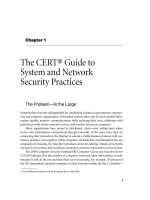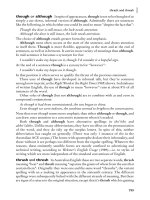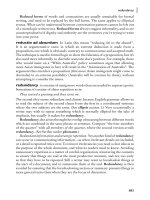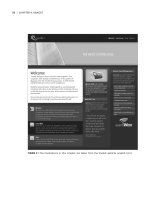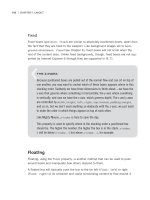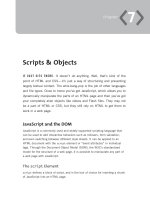The Best-Practice Guide to xHTML and CSS phần 10 pps
Bạn đang xem bản rút gọn của tài liệu. Xem và tải ngay bản đầy đủ của tài liệu tại đây (8.98 MB, 43 trang )
|
AppendIx b: css reference
smaller
xx-small
x-small
small
medium (default)
large
x-large
xx-large
[percentage]
[length]
Example
body { font—size: 80%; }
h1 { font—size: 2em; }
Related properties
font, font-family
font-style
Italic and oblique characteristics of a font.
See Chapter 2, “Text.”
Possible values
inherit
normal
italic
oblique
•
•
•
•
•
•
•
•
•
•
•
•
•
•
propertIes
|
Example
h1, h2 { font-style: italic }
Related properties
font, font-weight
font-variant
Used to convert lowercase letters to small uppercase letters.
See Chapter 2, “Text.”
Possible values
inherit
normal (default)
small-caps
Example
p { font-variant: small-caps; }
Related properties
font, text-transform
font-weight
The boldness of a font. Values 100 to 900 are supposed to be different scales of
boldness, but in practice browsers tend not to reliably differentiate between nine
separate levels, which is why the value of font-weight tends to be simply either
normal or bold.
See Chapter 2, “Text.”
Possible values
inherit
•
•
•
•
|
AppendIx b: css reference
100, 200, 300, 400, 500, 600, 700, 800, or 900
normal—Equivalent of 400
bolder
bold—Equivalent of 700
lighter
Example
.chubbybaby { font-weight: bold }
Related properties
font, font-style
height
Specifies the height of the content area of a block box (not including padding, bor-
der, or margin).
See Chapter 5, “Layout.”
Possible values
inherit
auto (default)
[percentage]
[length]
Example
#monstermunch {
padding: 1em;
height: 3em;
}
•
•
•
•
•
•
•
•
•
propertIes
|
Related properties
width, min-height, max-height
left
For absolutely positioned boxes, specifies how far from the left of the containing
positioned box (or the page, if there isn’t one) the box should be.
For relatively positioned boxes, specifies how far from the left a box should be
shifted.
See Chapter 5, “Layout.”
Possible values
inherit
auto (default)
[percentage]
[length]
Example
#sold {
position: absolute;
left: 150px;
}
Related properties
right, top, bottom, position
letter-spacing
The spacing between letters.
See Chapter 2, “Text.”
•
•
•
•
|
AppendIx b: css reference
Possible values
inherit
normal (default)
[Length]
Example
p { letter-spacing: 0.3em }
Related properties
word-spacing
line-height
The height of a line of text.
See Chapter 2, “Text.”
Possible values
inherit
normal—Usually about 1.2 times the height of the font.
[number]—A multiple of the font size (so, in effect, the same as a value
specified in ems).
[percentage]—A percentage of the font size.
[length]
Example
p { line-height: 1.5 }
Related properties
font, font-size
•
•
•
•
•
•
•
•
propertIes
|
list-style
A shorthand property used to specify the styles of a list item marker.
See Chapter 6, “Lists.”
Possible values
[combination of list-style-type, list-style-position, and list-style-image]
Example
ul { list-style: none url(images/arrow.gif) inside; }
ul ul { list-style: disc outside; }
#nav ul { list-style: none; }
Related properties
list-style-type, list-style-position, list-style-image
list-style-image
Specifies an image to be used as the list marker for a list item.
See Chapter 6, “Lists.”
Possible values
inherit
none (default)
[URI]
Example
ul { list-style-image: url(images/arrow.gif); }
Related properties
list-style, list-style-type
•
•
•
00
|
AppendIx b: css reference
list-style-position
Specifies whether the list marker for a list item should appear inside or outside the
list-item box. By default, lists will place the marker of each list item outside the
content box, which means that when it comes to styling list items with backgrounds
or borders, for example, the bullet will aloofly hang about outside. You can pull the
marker inside the content box to deal with such circumstances by setting the list-
style-position property to inside.
See Chapter 6, “Lists.”
Possible values
inherit
outside (default)
inside
Example
ul { list-style-position: inside; }
Related properties
list-style
list-style-type
The type of the list marker bullet or numbering system within a list. These can be
applied to any (non-definition) lists regardless of whether they are ordered or unordered.
See Chapter 6, “Lists.”
Possible values
inherit
none—No list marker. This can be handy when you want to present lists that
don’t appear in main content and don’t need to stand out from the crowd
with markers—as in navigation bars, for example.
•
•
•
•
•
propertIes
|
01
disc—Solid circle
circle—Hollow circle
square—Solid square
decimal (default for ol elements)—1, 2, 3, 4, etc.
decimal-leading-zero—01, 02, 03 10, 11, etc. Not supported by IE.
lower-roman—i, ii, iii, iv, etc.
upper-roman—I, II, III, IV, etc.
lower-greek—Greek characters. Not supported by IE.
lower-latin—a, b, c, d, etc. Not supported by IE.
upper-latin—A, B, C, D, etc. Not supported by IE.
armenian—Armenian characters. Not widely supported.
georgian—Georgian characters. Not widely supported.
Example
ol { list-style-type: lower-roman; }
ul { list-style-type: square; }
ul ul { list-style-type: circle; }
This example applies lower-roman numerals to ordered lists, square bullets to
top-level unordered lists, and circular bullets to all unordered lists nested within
unordered lists.
Related properties
list-style, list-style-image
margin, margin-top, margin-right, margin-bottom, margin-left
The margin of a box.
See Chapter 5, “Layout.”
•
•
•
•
•
•
•
•
•
•
•
•
0
|
AppendIx b: css reference
Possible values
inherit
[percentage]
[length]
The value for margin can comprise one value (uniform margin), two values
([top/bottom][left/right]), three values ([top][left/right][bottom]), or four values
([top][right][bottom][left]).
Example
#badger {
margin-top: 3em;
}
#wolverine {
margin: 1em 100px;
}
#pineapple {
margin: 1em 3em 10px 0.5em;
}
Related properties
padding, border
max-height
The maximum height of a box. Not supported by IE 6 or below.
Possible values
inherit
none
[percentage]
[length]
•
•
•
•
•
•
•
•
propertIes
|
0
Example
#bing { max-height: 300px; }
Related properties
min-height, height, max-width, min-width
max-width
The maximum width of a box. Not supported by IE 6 or below.
Possible values
inherit
none
[percentage]
[length]
Example
#bong { max-width: 780px; }
Related properties
min-width, width, max-height, min-height
min-height
The minimum height of a box. Not supported by IE 6 or below (where height acts
the same).
Possible values
inherit
none
[percentage]
[length]
•
•
•
•
•
•
•
•
0
|
AppendIx b: css reference
Example
#beng { min-height: 5em; }
Related properties
max-height, height, min-width, max-width
min-width
The minimum width of a box. Not supported by IE 6 or below.
Possible values
inherit
none
[percentage]
[length]
Example
#bung { min-width: 300px; }
Related properties
max-width, width, min-height, max-height
orphans
Used in paged media. The minimum number of lines in an element that must be
left at the bottom of a page. Not widely supported.
Possible values
inherit
[number]—(default is 2)
•
•
•
•
•
•
propertIes
|
0
Example
p { orphans: 3; }
Related properties
widows
outline
Specifies an outline for a box. Rendered around the outside of the border and on
top of the box, so it does not affect its size or position. The value can combine out-
line-color, outline-style, and outline-width. Not supported by IE/Win or Mozilla
at the time of writing.
Possible values
[Combines outline-color, outline-style, and outline-width]
Example
.ferrari { outline: 3px solid red; }
Related properties
outline-color, outline-style, outline-width, border
outline-color
The color of an outline. Not supported by IE/Win or Mozilla at the time of writing.
Possible values
invert
[color]
Example
.redbull { outline-color: blue; }
•
•
0
|
AppendIx b: css reference
Related properties
outline, border-color
outline-style
The style of an outline. Not supported by IE/Win or Mozilla at the time of writing.
Possible values
none—No border.
dotted—A series of dots.
dashed—A series of dashes.
solid—A solid line.
double—Two solid lines.
groove—Patterned border that is supposed to represent a carved groove
(opposite of ridge).
ridge—Patterned border that is supposed to represent an embossed ridge
(opposite of groove).
inset—Patterned border that is supposed to represent an inset depression
(opposite of outset).
outset—Patterned border that is supposed to represent an outset extrusion
(opposite of inset).
hidden—Used with tables. Same as none, except where there are conflicting
borders.
Example
.honda { outline-style: solid; }
Related properties
outline, border-style
•
•
•
•
•
•
•
•
•
•
propertIes
|
0
outline-width
The width of an outline. Not supported by IE/Win or Mozilla at the time of writing.
Possible values
thin
medium
thick
[length]
Example
.williams { outline-width: 0.5em; }
Related properties
outline, border-width
overflow
Specifies what should happen to the overflow—the portions of content that do not
fit inside the box.
See Chapter 5, “Layout.”
Possible values
inherit
visible (default)—Overflow spills over the box.
hidden—Any content that doesn’t fit in the box will be “clipped”—cut off at
the edge of the box.
scroll—Scrollbars appear, allowing the user to scroll the box to see the overflow.
auto—Scrollbars will only be displayed if they are necessary (whereas overflow:
scroll will show them even if the content of the box fits without any overflow).
•
•
•
•
•
•
•
•
•
0
|
AppendIx b: css reference
Example
#content {
width: 500px;
height: 4em;
overflow: hidden;
}
Related properties
clip, height, width
padding, padding-top, padding-right, padding-bottom,
padding-left
The padding of a box.
See Chapter 5, “Layout.”
Possible values
inherit
[percentage]
[length]
Value for padding can comprise one value (uniform padding), two values
([top/bottom][left/right]), three values ([top][left/right][bottom]), or four values
([top][right][bottom][left]).
Example
#flump { padding: 10em 2em; }
Related properties
border, margin
•
•
•
propertIes
|
0
page-break-after
Used in paged media. How a page break should be applied after a block box, forc-
ing a new page box. Not widely supported.
Possible values
inherit
auto (default)—Does not force or forbid a page break.
always—Always forces a page break.
avoid—Forbids a page break.
left—Forces either one or two page breaks so that the next page is a
left page.
right—Forces either one or two page breaks so that the next page is a
right page.
Example
#europe { page-break-after: left; }
Related properties
page-break-before, page-break-inside
page-break-before
Used in paged media. How a page break should be applied before a block box, forc-
ing a new page box. Not widely supported.
Possible values
inherit
auto (default)—Does not force or forbid a page break.
always—Always forces a page break.
•
•
•
•
•
•
•
•
•
10
|
AppendIx b: css reference
avoid—Forbids a page break.
left—Forces either one or two page breaks so that the next page is a left page.
right—Forces either one or two page breaks so that the next page is a
right page.
Example
#antarctica { page-break-before: always; }
Related properties
page-break-after, page-break-inside
page-break-inside
Used in paged media. How a page break should be applied inside a block box, forc-
ing a new page box. Not widely supported.
Possible values
inherit
auto (default)—Does not force or forbid a page break.
avoid—Forbids a page break.
Example
#africa { page-break-inside: avoid; }
Related properties
page-break-after, page-break-before
position
How a box should be positioned.
See Chapter 5, “Layout.”
•
•
•
•
•
•
propertIes
|
11
Possible values
inherit
static (default)—Follows the normal flow.
relative—Relative position that is offset from the initial normal position in the
flow.
absolute—Taken out of the flow and offset according to the containing block.
fixed—The same as absolute only the fixed box will remain fixed in the view-
port and not scroll (or will appear on every printed page). Not supported by
IE 6 or below.
Example
#oogabooga {
position: relative;
left: 1em;
top: 1em;
}
Related properties
float, top, bottom, left, right
quotes
What form the quotes of the open-quote and close-quote values of the content
property should take. Not supported by IE.
Possible values
inherit
none
[string] [string]—The first string is that used for the open-quote value and sec-
ond string for the close-quote value.
•
•
•
•
•
•
•
•
1
|
AppendIx b: css reference
[string] pairs can be repeated, whereby each consecutive pair will represent
the quotes for the next level of embedding. For example, ‘“‘ ‘“‘ “‘“ “‘“ will
specify that quotes within a quoted element will be surrounded by ‘ charac-
ters. Not widely supported.
Example
q { quotes: ‘“‘ ‘“‘ }
Related properties
content
right
For absolutely positioned boxes, specifies how far from the right of the containing
positioned box (or the page, if there isn’t one) the box should be.
For relatively positioned boxes, specifies how far from the right a box should be
shifted.
See Chapter 5, “Layout.”
Possible values
inherit
auto (default)
[percentage]
[length]
Example
#tolet {
position: relative;
right: 2em;
}
•
•
•
•
•
propertIes
|
1
Related properties
left, top, bottom, position
table-layout
Used to specify the algorithm that should be used to render a fixed-width table. Not
supported by early versions of IE.
See Chapter 8, “Tables.”
Possible values
inherit
auto (default)—Column widths are determined by the cells in all rows.
fixed—Column widths are determined by the cells in the first row only. Table
renders faster.
Example
table {
table-layout: fixed;
width: 100%;
}
Related properties
width
text-align
Horizontally aligns text within a block box, such as a default paragraph.
See Chapter 2, “Text.”
Possible values
inherit
left
•
•
•
•
•
1
|
AppendIx b: css reference
right
center
justify
Example
p { text-align: right; }
Related properties
[none]
text-decoration
Underline, over-line, or strikethrough.
See Chapter 2, “Text.”
Possible values
inherit
none
underline—Line underneath text.
overline—Line above text.
line-through—Line through the middle of text.
blink—Not supported by IE, or used by sensible people.
Example
ins { text-decoration: none }
Related properties
border
•
•
•
•
•
•
•
•
•
propertIes
|
1
text-indent
The indentation of the first line of text in a block box.
See Chapter 2, “Text.”
Possible values
inherit
[Percentage]
[Length]
Example
p { text-indent: 1em }
Related properties
[none]
text-transform
Converts the case of letters.
See Chapter 2, “Text.”
Possible values
inherit
none (default)
capitalize—Capitalizes the first letter of every word.
uppercase—Forces every letter into uppercase.
lowercase—Forces every letter into lowercase.
Example
h1, h2 { text-transform: uppercase }
•
•
•
•
•
•
•
•
1
|
AppendIx b: css reference
Related properties
font-variant
top
For absolutely positioned boxes, specifies how far from the top of the containing
positioned box (or the page, if there isn’t one) the box should be.
For relatively positioned boxes, specifies how far from the top a box should be
shifted.
See Chapter 5, “Layout.”
Possible values
inherit
auto (default)
[percentage]
[length]
Example
#forsale {
position: absolute;
top: 25%;
}
Related properties
bottom, left, right, position
unicode-bidi
Used in conjunction with direction, specifies how text is mapped to the Unicode
algorithm, determining its directionality.
•
•
•
•
propertIes
|
1
Possible values
inherit
normal (default)—No additional embedding. Applies the implicit Unicode char-
acter order.
embed—Opens an additional level of embedding within the algorithm whilst
maintaining the implicit Unicode character order.
bidi-override—Opens an additional level of embedding and overrides the
Unicode character ordering, reordering the sequence to the value of the direc-
tion property.
Example
.hebrew {
direction: rtl;
unicode-bidi: bidi-override;
}
Related properties
direction
vertical-align
The vertical position of an inline box, or content within a table cell. Values such as
top, middle, bottom, text-top and text-bottom rely on the styled box being smaller
than some or all of the text in the rest of the line (otherwise it will already be at all
of those positions).
See Chapter 2, “Text”.
Possible values
inherit
[length]—Raises (positive value) or lowers (negative value) the box; 0 is equal
to the baseline.
•
•
•
•
•
•
1
|
AppendIx b: css reference
[percentage]—Raises (positive value) or lowers (negative value) the box with
regard the value of line-height; 0% is equal to the baseline, 100% is one
times the line-height, etc.
baseline (default)—Aligns the baseline of a box with the baseline of its parent
box.
sub—Lowers the baseline to subscript level.
super—Raises the baseline to superscript level.
top—Aligns to the top of the line.
text-top—Aligns to the top of the font of the parent box.
middle—Aligns to the middle of the font of the parent box.
bottom—Aligns to the bottom of the line.
text-bottom—Aligns to the bottom of the font of the parent box.
Example
.power {
font-size: 80%;
vertical-align: super;
}
Related properties
line-height
visibility
Makes a box is visible or invisible.
See Chapter 5, “Layout.”
Possible values
inherit
visible (default)
•
•
•
•
•
•
•
•
•
•
•
